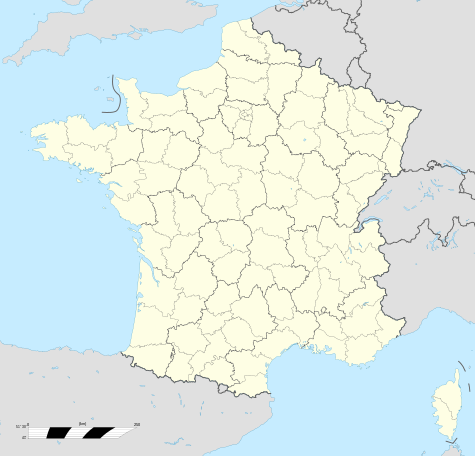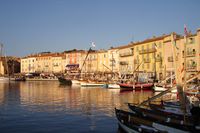Saint-Tropez
|
Saint-Tropez |
|
 |
|
| Church of Saint-Tropez | |
 Saint-Tropez
|
|
| Administration | |
|---|---|
| Country | France |
| Region | Provence-Alpes-Côte d'Azur |
| Department | Var |
| Arrondissement | Draguignan |
| Canton | Saint-Tropez |
| Mayor | Jean-Pierre Tuveri (2008–) |
| Statistics | |
| Elevation | 0–113 m (0–371 ft) (avg. 15 m/49 ft) |
| Land area1 | 15.18 km2 (5.86 sq mi) |
| Population2 | 5,690 (2006) |
| - Density | 375 /km2 (970 /sq mi) |
| INSEE/Postal code | 83119/ 83990 |
| 1 French Land Register data, which excludes lakes, ponds, glaciers > 1 km² (0.386 sq mi or 247 acres) and river estuaries. | |
| 2 Population sans doubles comptes: residents of multiple communes (e.g., students and military personnel) only counted once. | |
Saint-Tropez (Sant Tropetz in Occitan) is a town, 104 km to the east of Marseille, in the Var department of the Provence-Alpes-Côte d'Azur region of southeastern France. It is also the principal town in the canton of Saint-Tropez.
It is located on the French Riviera, and it is known today for its famous and extremely wealthy summertime guests. It has been dubbed the 'playground to jetsetters, fashion models, and millionaires', and it is most-enduringly known as the place the iconic Brigitte Bardot "discovered" and for its role in the liberation of southern France during World War II.
Saint-Tropez has had a varied history. It was a fifteenth-century military stronghold, an unassuming fishing village at the beginning of the twentieth century, and the first town on this coast to be liberated during World War II (as part of Operation Dragoon). After the war, it became an internationally-known seaside resort, renowned principally because of the influx of artists of the French New Wave in cinema and the Yé-yé movement in music. In latter years, it has been a resort for the European and American jet set and the inevitable hordes of tourists in search of a little Provençal authenticity and an occasional celebrity sighting.
The inhabitants of Saint-Tropez are called Tropéziens[1], and the town is familiarly called "St-Trop".
Contents |
History
The town’s name derives from that of an early, semi-legendary martyr named Saint Torpes. His legend states that he was beheaded at Pisa during the reign of Nero, and that his body was placed in a rotten boat with a rooster and a dog. The body landed at the present-day location of the town.[2][3][4]
Saint-Tropez and its surroundings were dominated by the nearby Saracen settlement of Fraxinet during the ninth and tenth centuries.[5]
The local nobleman had the privilege of raising a standing army, which drove away a fleet of Spanish galleons in 1637. Les Bravades des Espagnols is a local religious and military celebration commemorating this victory of the Tropezian militia over the Spanish.[6]
The area was not taxed by the French government during this time. However, this tax-free privilege was abrogated by King Louis XIV, who reasserted French control over the city.
The Japanese samurai, Hasekura Tsunenaga, and his retainers, en route to Rome, visited Saint-Tropez in September 1615, in what is believed to be the earliest instance of contact between the French and the Japanese.
The famous admiral, Pierre André de Suffren de Saint Tropez (1729–1788), was the third son of the marquis de Saint-Tropez.
In the 1920s Saint-Tropez attracted famous figures from the world of fashion, like Coco Chanel and Elsa Schiaparelli.
During World War II, on 15 August 15, 1944, it was the site of a military landing called Operation Dragoon, the Allied invasion of southern France.
In the 1950s, partly thanks to Brigitte Bardot, Saint-Tropez became renowned internationally. It was the setting for such films as And God Created Woman. During the 1960s and the 1970s, the film series Le gendarme de Saint-Tropez with Louis de Funès further contributed to the town's reputation.
Port
The port was widely used during the 18th century; in 1789, the port was visited by 80 ships. Saint-Tropez’s shipyards built tartanes and three-masted ships that carried 1000 to 12200 barels. The town was the site of various associated trades, including fishing, cork, wine, wood. The town had a school of hydrography. In 1860 the floret of the merchant marine, named "The Queen of the Angels" (a three-masted ship of 740 barrels), visited this port.
Its role as a commercial port declined, and it is now primarily a tourist spot besides being a base for many well know sail regattas. Here you also find a fast boat transportation with Les Bateaux Verts to Sainte Maxime on the other side of the bay and to Port Grimaud, Marines de Cogolin, Les Issambres and St-Aygulf.
Economy
The main economic resource of Saint-Tropez is tourism.
Saint-Tropez is well known for the Hôtel Byblos (and Les Caves du Roy), a member of the Leading Hotels of the World, whose inauguration with Brigitte Bardot and Gunter Sachs in 1967 was an international event.
Art and Saint-Tropez
In history of modern art Saint-Tropez plays a major role. Paul Signac discovers this light fulfilled place and inspires painters like Matisse, Bonnard or Marquet to come to Saint-Tropez. Saint-Tropez emerges the painting of Pointillism and Fauvism. Also for the next generation of painters Saint-Tropez rests an interesting attraction. Bernard Buffet, David Hockney, Massimo Campigli, Donald Sultan were also living and working in Saint-Tropez. Today Stefan Szczesny continues this tradition.
Events
Each year, in early October, a regatta is held in the bay of Saint-Tropez (Les Voiles de St. Tropez). This is a draw for many yachts, some up to 50 metres in length. Many tourists come to the location for this event or as a stop on their trip to Cannes, Marseille or Nice.
Beaches
Tropezien beaches are located along the coast in the Baie de Pampelonne also know by the residents as Grania (pronounced granny-ay), which lies south of Saint-Tropez and east of Ramatuelle. Pampelonne offers a collection of beaches along its five kilometre shore. Each beach is around thirty metres wide with its own beach hut and private or public tanning area.
Many of the beaches offer windsurfing, sailing and canoeing equipment for rent, while others offer motorized water sports, such as power boats, jet bikes and water skiing, scuba diving.
Some of the private beaches are naturist beaches.
Gallery
 Saint-Tropez "le vieux port" (the old port) |
The beaches of Pampelone and Bonne Terrase |
 Cannons of the Citadel |
 The Tour Jarlier in Saint Tropez |
 Brigitte Bardot at St. Tropez, 1963 |
The Saint-Tropez Marina |
 View of the port of Saint-Tropez |
See also
- Communes of the Var department
References
- ↑ gentilé sur le site habitants.fr Consulté le 18/05/2008.
- ↑ http://www.nrj-saint-tropez.com/saint-tropez/st-tropez-135.html
- ↑ San Torpete (Torpes, Torpè)
- ↑ History of Saint-Tropez
- ↑ P. Sénac, "Contribution a l'étude des incursions Musulmanes dans l'Occident Chrétien: la localisation du Ğabal al-Qilāl" Revue de l'Occident Musulman et de la Méditerranée, 31 (1981) 7–14
- ↑ Nicola Williams, Catherine Le Nevez, Provence and the Cote D'Azur (Lonely Planet, 2007), 343.
External links
- City Administration St Tropez
- Office of tourism of Saint-Tropez
- Phonebook of St Tropez
- St Tropez Web Radio
- Touristic Site of Saint Tropez
|
|||||